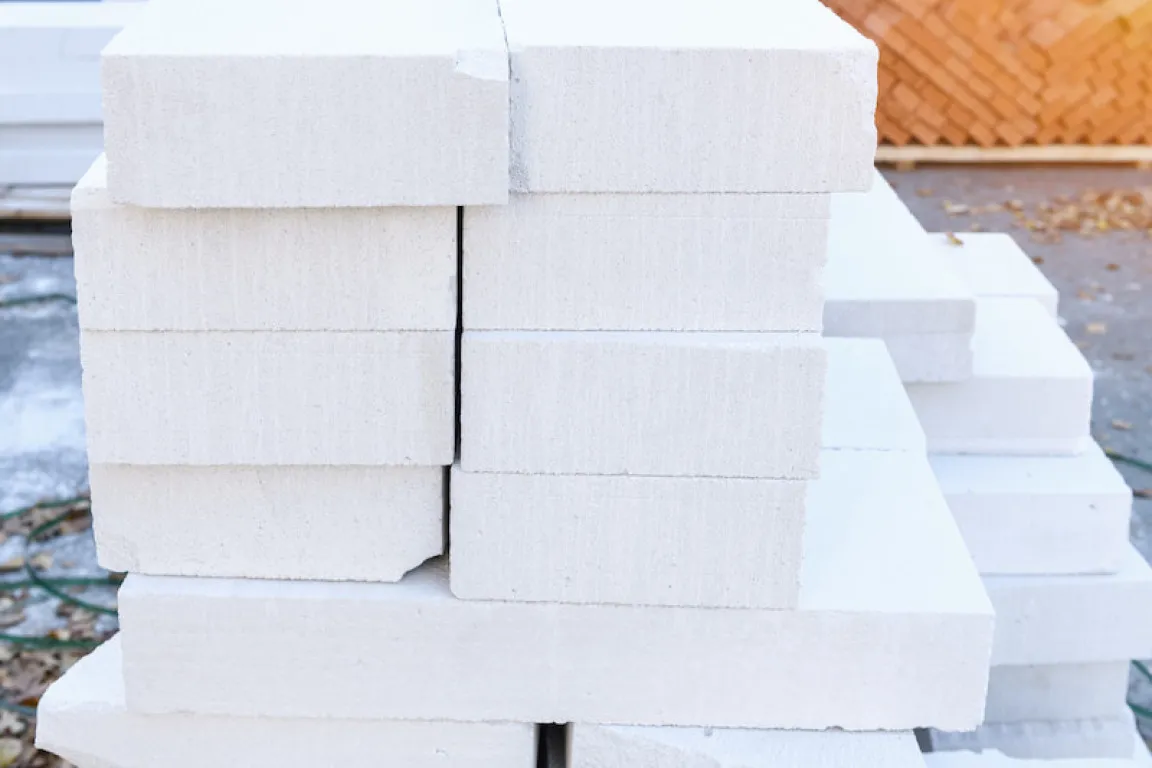Perlu diketahui, bata ringan atau hebel memiliki ukuran yang berbeda-beda. Maka dari itu, Anda harus mengetahui cara menghitung bata ringan per m2 yang tepat agar tidak salah perkiraan ketika hendak melakukan pembangunan. Bahan baku bata ringan sendiri biasa disebut beton ringan jenis AAC (Autoclaved Aerated Concrete), yang merupakan perpaduan dari pasir silica, semen, alumunium pasta, dan bahan lainnya.
Bata ringan sangat diminati karena memiliki banyak kelebihan. Salah satu kelebihan bata ringan yang perlu Anda ketahui adalah tahan air dan tahan panas. Bagi Anda yang belum mengetahui cara menghitung bata ringan yang tepat, simak artikel ini sampai tuntas.
Cara Menghitung Volume Bata Ringan atau Hebel
Hebel atau bata ringan merupakan salah satu material konstruksi tahan gempa yang bisa Anda gunakan. Perlu diketahui, hebel memiliki beberapa ukuran yang berbeda-beda. Maka dari itu, penting untuk mengetahui ukuran-ukurannya sebelum melanjutkan ke pembahasan cara menghitung bata ringan.
Pada umumnya, bata ringan atau hebel dijual dalam satuan kubik. Jadi, karena ukurannya berbeda-beda, maka setiap kubik dari masing-masing ukuran memiliki jumlah yang berbeda pula. Adapun jenis-jenis ukuran bata ringan adalah sebagai berikut.
- Hebel 5: Panjang 60 cm, lebar 20 cm, tebal 5 cm.
- Hebel 7,5: Panjang 60 cm, lebar 20 cm, tebal 7,5 cm.
- Hebel 10: Panjang 60 cm, lebar 20 cm, tebal 10 cm.
- Hebel 12,5: Panjang 60 cm, lebar 20 cm, tebal 12,5 cm.
- Hebel 15: Panjang 60 cm, lebar 20 cm, tebal 15 cm.
- Hebel 20: Panjang 60 cm, lebar 20 cm, tebal 20 cm.
Dengan mengetahui ukuran dari bata ringan yang akan digunakan, maka Anda bisa melakukan perhitungan untuk memperkirakan jumlah kebutuhan dari bata ringan pada proses pembangunan.
Baca juga: Hebel vs. Bata merah, Mana Lebih Bagus? Cek Perbandingannya!
Cara Menghitung Kebutuhan Bata Ringan per M2
Pada dasarnya, cara menghitung bata ringan terbilang mudah untuk dilakukan. Hal yang perlu dipersiapkan sebelum melakukan perhitungan adalah gambar rancangan dari bangunan yang hendak dikerjakan. Berbekal gambar rancangan tersebut, Anda bisa menghitung hebel atau bata ringan dengan lebih mudah.
1. Hitung Luas Tembok
Cara menghitung bata ringan yang pertama adalah hitung luas tembok atau dinding yang hendak dibangun. Dengan menggunakan gambar rancangan bangunan sebagai acuan, Anda bisa melakukan perhitungan luas tembok yang hendak dibangun menggunakan rumus berikut ini.
Luas Tembok = Panjang tembok x Tinggi tembok
Jika bentuk bangunan yang hendak dikerjakan kompleks, Anda bisa membagi terlebih dahulu area tembok atau dindingnya. Dengan begitu, Anda tidak akan kesulitan lagi ketika melakukan perhitungan luasnya. Selain itu, dengan membagi area tembok dan dinding dapat menghindari kesalahan ketika melakukan perhitungan.
Baca juga: Jenis dan Fungsi Gips untuk Bangunan
2. Hitung Jumlah Kebutuhan Hebel
Setelah mengetahui luas tembok, Anda bisa melanjutkan ke perhitungan jumlah kebutuhan hebel per m2. Adapun cara menghitung bata ringan per m2 adalah sebagai berikut.
(a) Menghitung luas dari bata ringan atau hebel dengan menggunakan rumus berikut:
Luas Bata Ringan = Panjang bata x Tinggi bata
(b) Menghitung 1 m2 berapa hebel dengan menggunakan rumus berikut ini.
Kebutuhan Hebel = Luas tembok : Luas bata ringan
Perlu diingat, sebelum melakukan perhitungan Anda harus menyamakan satuannya terlebih dahulu. Seperti yang sudah diketahui, ukuran dari bata ringan menggunakan satuan sentimeter, sedangkan yang dicari adalah jumlah hebel per m2. Maka dari itu, sebaiknya Anda mengubah satuan dari ukuran bata ringannya terlebih dahulu menjadi meter agar mempermudah serta menghindari kesalahan dalam perhitungan.
3. Hitung Kebutuhan Hebel dalam m3
Cara menghitung bata ringan yang terakhir adalah menghitung kebutuhan hebel dalam m3. Seperti yang sudah dibahas sebelumnya, pada umumnya hebel atau bata ringan dijual per kubik atau per m3 bukan per biji. Berikut merupakan cara menghitung bata ringan per kubik yang bisa Anda ikuti.
(a) Menghitung volume dari bata ringan atau hebel dengan menggunakan rumus berikut ini:
Volume Bata Ringan = Panjang bata x Tinggi bata x lebar/tebal bata
(b) Menghitung kebutuhan hebel per kubik dengan menggunakan rumus berikut ini:
Kebutuhan Hebel Per Kubik = Kebutuhan Hebel x Volume Bata Ringan
Dalam perhitungan volume bata ringan, Anda harus memperhatikan ketebalan dari bata yang Anda gunakan karena pada umumnya panjang dan tinggi bata ringan sama, yang membedakan hanya ketebalannya saja. Pada umumnya, untuk pembangunan rumah akan menggunakan hebel atau bata ringan dengan ketebalan 7-10 cm.
Baca juga: Begini Cara Menghitung Kebutuhan Semen Agar Tidak Salah
Simulasi Menghitung Kebutuhan Bata Ringan
Mengingat harus melalui beberapa tahapan, Anda perlu melakukan beberapa latihan untuk dapat memahami cara menghitung bata ringan di atas. Untuk dapat membantu Anda memahaminya, coba simak simulasi perhitungan kebutuhan bata ringan berikut ini.
Diketahui, sebuah area yang akan dibuat tembok memiliki ukuran panjang 15 meter dengan ketinggian 4 meter. Bata ringan yang dipilih menggunakan ukuran hebel 10 (panjang 60 cm, lebar 20 cm, tebal 10 cm). Adapun perhitungan kebutuhan bata ringannya adalah sebagai berikut.
Luas Tembok = Panjang tembok x Tinggi tembok
Luas Tembok = 15 m x 4 m
Luas Tembok = 60 m2
Dari perhitungan tersebut, didapatkan hasil untuk luas tembok adalah 60 m2. Selanjutnya, akan dilakukan perhitungan jumlah kebutuhan hebel. Adapun perhitungannya adalah sebagai berikut.
Luas Bata Ringan = Panjang bata x Tinggi bata
Luas Bata Ringan = 60 cm x 20 cm
Luas Bata Ringan = 1200 cm2 = 0,12 m2
Kebutuhan Hebel = Luas tembok : Luas bata ringan
Kebutuhan Hebel = 60 m2 : 0,12 m2
Kebutuhan Hebel = 500
Dari perhitungan tersebut, jumlah kebutuhan bata ringan atau hebel adalah sebanyak 500 buah. Selanjutnya adalah langkah terakhir, yakni menghitung kebutuhan bata ringan per kubik, perhitungannya adalah sebagai berikut.
Volume Bata Ringan = Panjang bata x Tinggi bata x lebar/tebal bata
Volume Bata Ringan = 60 cm x 20 cm x 10 cm
Volume Bata Ringan = 12000 cm3 = 0,012 m3
Kebutuhan Hebel Per Kubik = Kebutuhan Hebel x Volume Bata Ringan
Kebutuhan Hebel Per Kubik = 500 x 0,012 m3
Kebutuhan Hebel Per Kubik = 6 m3
Berdasarkan perhitungan yang sudah dilakukan, kebutuhan bata ringan atau hebel per kubik untuk tembok tersebut adalah sebesar 6 m3.
Perlu diketahui, hasil perhitungan tersebut hanyalah perkiraan karena ada beberapa faktor lain yang bisa memengaruhi jumlah kebutuhan bata ringan, seperti ketebalan semen dan pemotongan bata ringan tersebut. Untuk mendapatkan hasil perhitungan yang lebih akurat, Anda bisa meminta bantuan para profesional. Dengan mendapatkan hasil yang lebih akurat, Anda bisa menghemat biaya bahan bangunan yang diperlukan.
Itulah beberapa informasi mengenai cara menghitung bata ringan yang perlu Anda ketahui. Selain memperkirakan jumlah batu bata, Anda juga perlu memperhatikan kualitas semen yang akan digunakan untuk menghindari kerugian. Dengan menggunakan semen berkualitas, bangunan Anda akan lebih kokoh sehingga tidak memerlukan biaya perawatan yang besar.
Untuk Anda yang hendak mencari semen berkualitas, Semen Merah Putih bisa menjadi pilihan utama. Semen Merah Putih memiliki kualitas yang tinggi dan terpercaya, hal tersebut dibuktikan dengan terpenuhinya persyaratan standar mutu Indonesia SNI 7064:2014.
Jika Anda mempunyai pertanyaan lebih lanjut mengenai produk Semen Merah Putih, Anda bisa menghubungi lewat formulir kontak berikut. Jadi tunggu apalagi? Bersama Semen Merah Putih, jadikan bangunan Anda semakin kokoh dan tahan lama.
Baca juga: Cara Menghitung Volume Fondasi Berdasarkan Jenisnya



